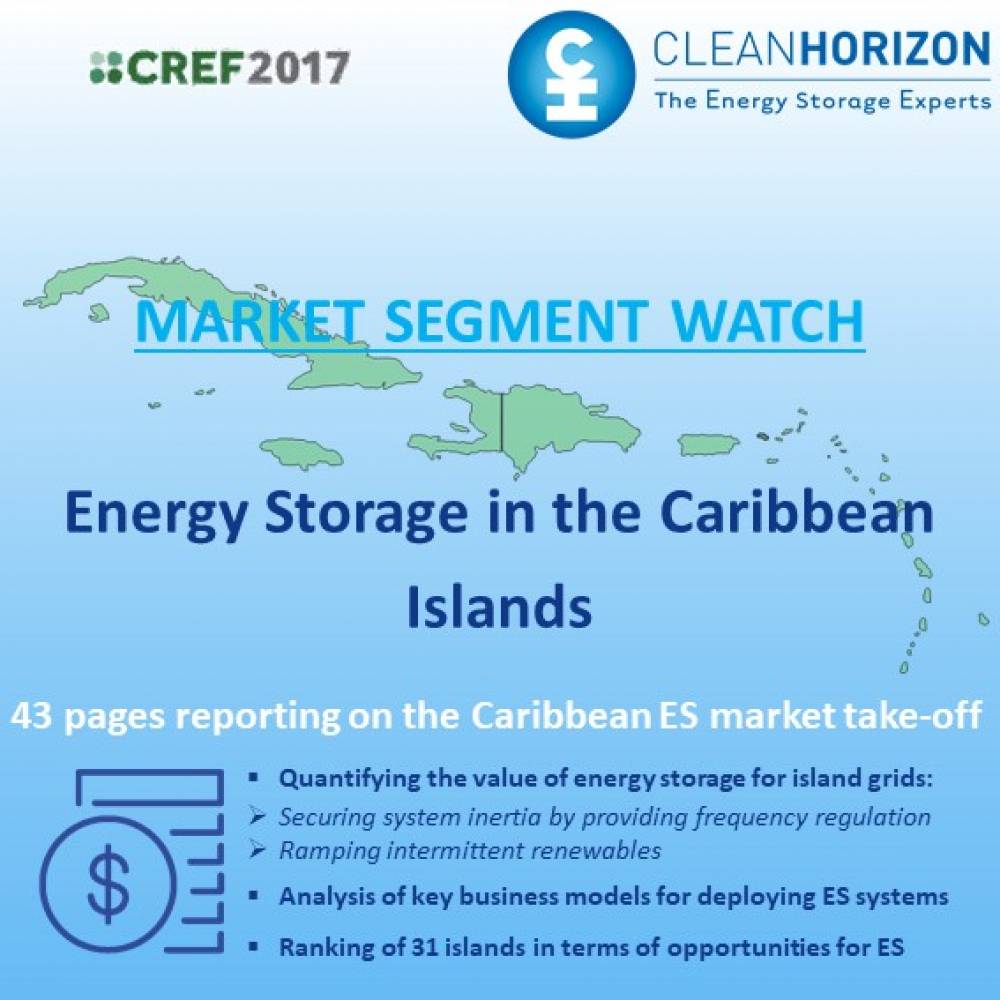Market Segment Watch Caribbean Islands 2017
1295 €
A report highlighting the key business cases for the Caribbean islands, namely diesel mitigation with PV plus storage and spinning reserve replacement. Additionally, this report contains detailed informations on the electricity background of four characteristic islands (Dominican Republic, Jamaica, Guadeloupe, Barbados). On behalf of Clean Horizon, we would like to extend our sincerest sympathies to those impacted by hurricanes Irma, Jose and Maria in the Caribbean. Clean Horizon supports the Waitt institute to help Barbuda’s reconstruction.
Description
TABLE OF CONTENTS
Changes in the international energy storage market
Lithium-ion as the leading technology
The decrease in lithium-ion battery prices
1. Island grids
1.1. Island grid characteristics
1.2. Impact of intermittent renewables on an island grid
1.2.1. Increasing need for reserve in volume
1.2.2. Reduced system inertia
1.3. Value of storage in the islands
1.3.1. Frequency regulation
1.3.2. Collocating renewables with storage
2. Business models to deploy storage in the islands
2.1. Power purchase agreement (PPA) for renewables plus storage
2.1.1. The business model
2.1.2. Illustration of the business case with Puerto Rico
2.1.3. Pros and cons of this business model
2.2. Utility purchases and operates the storage system
2.2.1. The business model
2.2.2. St. Eustatius snapshot
2.2.3. Pros and cons of this business model
2.3. Tolling agreement
2.3.1. The business model
2.3.2. Snapshot: California using energy storage to replace peakers
2.3.3. Pros and cons of the business model
3. Ranking the opportunities in the Caribbean for energy storage
3.1. Criteria for energy storage opportunity
3.1.1. Share of intermittent renewable capacity
3.1.2. Oil-fired generation
3.1.3. Enabling environment for renewable energy investment
3.2. Ranking of 31 Caribbean jurisdictions
3.3. Analysis of key jurisdictions for energy storage business
3.3.1. Guadeloupe and Martinique
3.3.2. Jamaica
3.3.3. Dominican Republic
3.3.4. Curacao
3.3.5. Barbados
4. Energy storage projects in the Caribbean
TABLE OF FIGURES
Figure 1: Technology split of energy storage systems (in capacity) installed globally in 2016
Figure 2: Cost of the DC battery container (Ex Works) for MW-scale systems
Figure 4: Jamaica electrical system inertia for different VRE production
Figure 5: Frequency drift as a function of intermittent renewables penetration
Figure 6: Opportunity for energy storage to replace spinning reserve and render less expensive generation capacity available
Figure 7: Stakeholders and roles – PPA for renewables plus storage
Figure 8: Frequency regulation constraints in Puerto Rico for a PV farm
Figure 9: Example of PV generation forecast and corresponding production plan in the French islands
Figure 10: Stakeholders and roles – utility buys and operates
Figure 11: Operation of the hybrid PV plus storage plant in St Eustatius
Figure 12: Stakeholders and roles – tolling agreement
Figure 13: Share of intermittent renewables capacity in the different Caribbean islands
Figure 14: Amount of oil-fired generation in the Caribbean (in MW)
Figure 15: Enabling environment for renewable energy investment in the Caribbean (Source: Castalia 2016)
Figure 16: Ranking of the Caribbean jurisdictions based on the opportunity they represent for storage
Figure 17: Electricity mixes of Guadeloupe (left) and Martinique (right) as of 2014 (GWh)
Figure 18: Guadeloupe and Martinique renewables plus storage targets
Figure 19: JPS net electricity generation in 2014, excluding IPPs generation share (in GWh)
Figure 20: Dominican Republic energy mix by generation source in 2015
Figure 21: Barbados electricity generation portfolio totaling 249 MW (MW)
